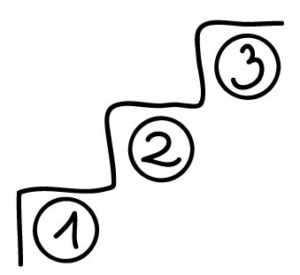 No Blame Approach consist of three steps:
No Blame Approach consist of three steps:
7.3.1 Meeting with the affected student
 No Blame Approach consist of three steps:
No Blame Approach consist of three steps:
7.3.1 Meeting with the affected student
The first meeting with the affected student is crucial. The teacher expresses his/her concern about the situation, assures the student that he/she will take initiative to help him or her and conveys confidence that the situation will change. By doing this the teacher signalizes first of all that he/she knows about the bullying and is determined to intervene.
The teacher informs the parents of the affected student about the intervention (see also comment: Parents and the No Blame Approach). Parents can contribute a lot to the success of the NBA by being positive about it and not insisting on sanctions. Research has shown that parental intervention (addressing the bully themselves or contacting the parents of the bully) leads to an aggravation of the incidents and is most likely contra productive.5
The second step (and most challenging) one is the meeting with the “support group”, consisting of the bully(ies) and colluders/bystanders on the one hand and friendly students on the other hand (6-8 pupils). The students receive an individual invitation for a meeting during classes. There needs to be a close consultation with the teacher whose lesson is concerned. The support group meets in a separate room. Initially, the teacher expresses also here his/her deep concern about the fact that one of the students is being bullied and clarifies that this is an unacceptable situation which needs to be changed. He/she tries to arouse empathy with the affected student. Then he/she is going to ask the students for help to overcome the bullying and addresses them as “experts” for the situation in class. This expresses the explicit difference to other bullying interventions.
This attitude also involves the protagonists, in a setting where it is obvious that the teacher knows who is bothering whom it will not be possible for the bullies to just continue. They are observed by teachers and classmates. But – and this is the big chance for them: stopping the deviant behavior now also means not being punished plus having the chance to re-define their role in class, it is face saving. The teacher explicitly mentions a positive skill each of the students has, including the bullies, focusing on resources rather than on deficits. The next step is to ask the students to come up with concrete ideas how to help/support the affected student X. What can be done? (E.g. walking X home, inviting X, spending time with X…) The teacher takes notes of the ideas on a flipchart/ blackboard and adds the names that are responsible for what. In the case of the protagonist(s), it is sufficient to say: I will stop bothering him/her.
Finally, the teacher thanks the students for their constructive ideas and support and finds a date for follow-up meetings.
The first meeting will be held with the affected student in a separate room.
If the answers are positive, the bullying has stopped and classmates are friendly and supportive the NBA was successful. The teacher will thank the student for the trust and invite him/her to turn to him/her in case of difficulties.
However, if this is not the case, the teacher will announce a second meeting with the support group and assure the student that he/she will continue to take care of the problem.
After the meeting with the affected student the teacher meets the members of the support group individually. He/she asks for an estimate how the affected student is feeling now. Have things improved? What did you notice? Were you able to contribute? Do you have any other ideas what can be done? In case of a positive course (the bullying stopped) the teacher expresses his thankfulness about the constructive role the student played. In case of an unsatisfying development the teacher announces another meeting of the support group in order to reflect the effectiveness of measures and develop new ideas.
Nevertheless, in case of a failure, other measures should be considered.